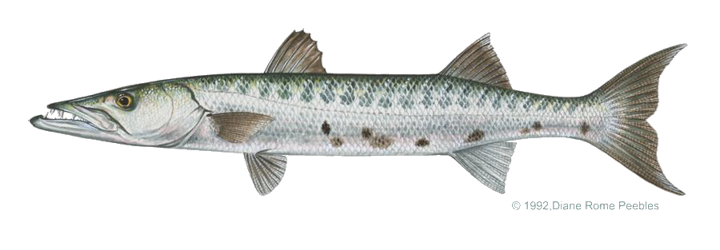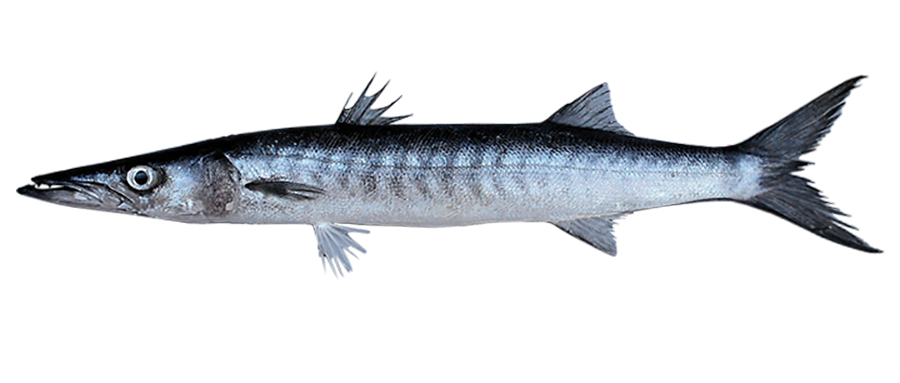Game Fish Identification Reference Guides
Barracuda, Guinean
(Sphyraena afra)
(Sphyraena afra)

Peters, 1844; SPHYRAENIDAE FAMILY; also called Guinese-barrakuda, bicuda-da-Guiné, becuda, bicuda-da-Guiné
This fish occurs in tropical waters of the Eastern Atlantic, from Mauritania to Namibia. It is found along the continental shelf and commonly enters lagoons and estuaries. Generally smaller fish are sometimes found in schools, however adults are generally solitary.
The sides are marked with about 20 dark, largely open chevrons that angle forward, these markings become less distinct in large specimens. There are no white tips on the fins, or black blotches on the body. Other distinguishing characteristics; the bony edge of the opercle ends in 2 points, the dorsal fin origin is distinctly behind the level of pelvic fin origins. The strong, pointed teeth are contiguous, flattened, those of the lower jaw erect, never slanting backward. Scales are small, 122 to 140 lateral line pores.
Guinean barracuda reportedly grows to 6.7 ft (205 cm) and attains a weight of 110.2 lb (50.0 kg). The temperament and fishing methods are similar to the great barracuda (see above description).
This species is considered to be a good food fish and has never been reported to be ciguatoxic. As an additional note; there are no documented reports of ciguatera from any Sphyraena species from the Eastern Central Atlantic
This fish occurs in tropical waters of the Eastern Atlantic, from Mauritania to Namibia. It is found along the continental shelf and commonly enters lagoons and estuaries. Generally smaller fish are sometimes found in schools, however adults are generally solitary.
The sides are marked with about 20 dark, largely open chevrons that angle forward, these markings become less distinct in large specimens. There are no white tips on the fins, or black blotches on the body. Other distinguishing characteristics; the bony edge of the opercle ends in 2 points, the dorsal fin origin is distinctly behind the level of pelvic fin origins. The strong, pointed teeth are contiguous, flattened, those of the lower jaw erect, never slanting backward. Scales are small, 122 to 140 lateral line pores.
Guinean barracuda reportedly grows to 6.7 ft (205 cm) and attains a weight of 110.2 lb (50.0 kg). The temperament and fishing methods are similar to the great barracuda (see above description).
This species is considered to be a good food fish and has never been reported to be ciguatoxic. As an additional note; there are no documented reports of ciguatera from any Sphyraena species from the Eastern Central Atlantic














